Destruction to all he touched or looked upon!
The last time we met Boris Karloff and Bela Lugosi at this site and under this byline was in The Black Cat (1934). Well, gentle reader, in comparing that film with The Invisible Ray, made two years later and featuring the same two actors, we’ll have to bring our expectations down a few notches in most categories—and those lower expectations will have no surprises.
Its failings are the wandering plot, the weak dialogue, some reused sets from other Universal films, the bogus science (though that goes with the territory) and even the disappointing music score from a composer of Franz Waxman’s stature, especially after his landmark score for The Bride of Frankenstein the year before. And, oh, yes: the mannered acting, often distracting and occasionally amusing, of presumed leading lady Frances Drake is overshadowed by the dark lady of the tale, intended as a secondary character.
Besides the reliable little monoplane that chugs around the Universal Pictures globe, there are here the familiar trademarks that made that studio the preeminent horror purveyor of the’30s and ’40s. The Invisible Ray is worth watching for the dark, shadowy German expressionism and the always competent cinematography, though it rarely approaches anything so intentional or sophisticated as what could be called “style.” Karloff and Lugosi, reliable like the little plane, remain convincing in their roles and a joy to watch, so naturally do they inhabit their surroundings of horror.
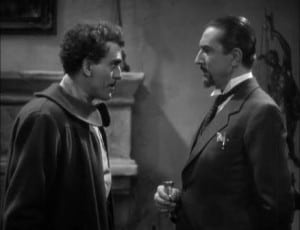 To whatever the degree, the film is elevated by its director Lambert Hillyer, new to the horror genre with this film. Well established as the director and writer who made William S. Hart and many other stars famous in a number of early Westerns, Hillyer went on to become one of Universal’s most reliable “B” movie directors. Many of his films, to no surprise, are Westerns.
To whatever the degree, the film is elevated by its director Lambert Hillyer, new to the horror genre with this film. Well established as the director and writer who made William S. Hart and many other stars famous in a number of early Westerns, Hillyer went on to become one of Universal’s most reliable “B” movie directors. Many of his films, to no surprise, are Westerns.
In The Invisible Ray, George Robinson is Hillyer’s cinematographer. Although the two men share credit for the underrated Dracula’s Daughter, also made in 1936, it would be Robinson who more avidly pursued the horror genre. He established himself with a number of such films, some classics, some less so: Dracula, The Mystery of Edwin Drood, Son of Frankenstein, The Mummy’s Tomb, Frankenstein Meets the Wolf Man, Son of Dracula, The Cat Creeps and others.
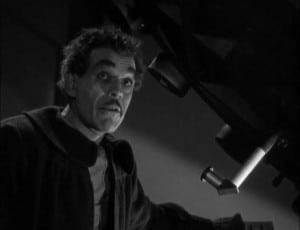 As in The Black Cat, in The Invisible Ray visitors arrive at an old dwelling, this one in the Carpathian Mountains. In this case it’s a repeat arrival by Lugosi, now as Dr. Felix Benet, with his friend Sir Francis Stevens (Walter Kingsford). Fortunately at home, and once again master of another house, is Karloff. In The Black Cat, he is Hjalmar Poelzig, leader of a satanic cult. Now as Dr. Janos Rukh, he has built in his lab a telescope that can peer into space at several thousand times the speed of light, beyond Saturn and even the Andromeda galaxy. (Among any number of astrophysical errors that would annoy Neil deGrasse Tyson, the background pattern of stars never changes as the telescope focuses deeper and deeper into space!)
As in The Black Cat, in The Invisible Ray visitors arrive at an old dwelling, this one in the Carpathian Mountains. In this case it’s a repeat arrival by Lugosi, now as Dr. Felix Benet, with his friend Sir Francis Stevens (Walter Kingsford). Fortunately at home, and once again master of another house, is Karloff. In The Black Cat, he is Hjalmar Poelzig, leader of a satanic cult. Now as Dr. Janos Rukh, he has built in his lab a telescope that can peer into space at several thousand times the speed of light, beyond Saturn and even the Andromeda galaxy. (Among any number of astrophysical errors that would annoy Neil deGrasse Tyson, the background pattern of stars never changes as the telescope focuses deeper and deeper into space!)
In the process, Rukh’s telescope can pick up rays of light that show the Earth’s past, so that a meteorite hitting Africa millions of years ago is witnessed in the present by the group of scientists gathered for Rukh’s demonstration. Seeing the meteorite strike, the group invites Rukh to join them in an expedition to Africa in search of the meteorite.
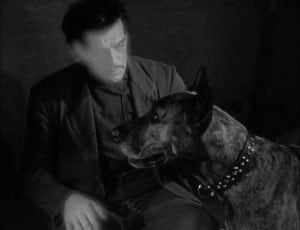 Found it is, but Rukh is contaminated by its strong radiation, Radium X. The dire consequences involve a ghostly glow from his flesh (with the help of special effects artist Raymond Lindsay) and a touch from him that brings instant death. He first accidentally discovers this on a hapless dog he pets. Benet has developed, however, a serum that suppresses the symptoms but does not cure Rukh, though, without it, death will be certain and quick. Benet gives him a packet of three vials and a hypodermic needle, all the serum there is. This glow appears when the serum begins to wear off, and, as Benet warns Rukh, once the serum is gone, he’ll “literally crumble to an ash.”
Found it is, but Rukh is contaminated by its strong radiation, Radium X. The dire consequences involve a ghostly glow from his flesh (with the help of special effects artist Raymond Lindsay) and a touch from him that brings instant death. He first accidentally discovers this on a hapless dog he pets. Benet has developed, however, a serum that suppresses the symptoms but does not cure Rukh, though, without it, death will be certain and quick. Benet gives him a packet of three vials and a hypodermic needle, all the serum there is. This glow appears when the serum begins to wear off, and, as Benet warns Rukh, once the serum is gone, he’ll “literally crumble to an ash.”
As an upshot of Rukh’s so-called “invisible” ray—quite visible in this instance—it restores sight to his blind mother (Violet Kemble Cooper), who warns early on he is delving into forbidden science and, later, not to go to Africa. With an ashen face, black attire and cryptic statements, she clearly seems the potential villain of this little enterprise, but proves to be not only one of its few survivors but someone who sets things right. More charismatic than leading lady Drake, Cooper made only eight films, between 1933 and 1936; her younger sister, Lillian Kemble Cooper, Bonnie Blue Butler’s nurse in London in Gone With the Wind, made over three times the films.
 During the African venture, Rukh’s wife Diane (Drake) has fallen for Ronald (boyish looking Frank Lawton, the mature David in George Cukor’s David Copperfield). Ronald is the nephew of Lady Stevens (Beulah Bondi, James Stewart’s mother in It’s a Wonderful Life), who has little to do in the film. Bent on revenge, and with the serum slowly driving him mad, Rukh goes to Paris where he fakes his own death. Ronald and Diane then marry. Rukh plans to use his Radium X malady to eliminate the couple and members of the African expedition. Benet, for one, in trying to use a gun from his pocket, is stopped by Rukh, whose restraining hand immediately kills Benet.
During the African venture, Rukh’s wife Diane (Drake) has fallen for Ronald (boyish looking Frank Lawton, the mature David in George Cukor’s David Copperfield). Ronald is the nephew of Lady Stevens (Beulah Bondi, James Stewart’s mother in It’s a Wonderful Life), who has little to do in the film. Bent on revenge, and with the serum slowly driving him mad, Rukh goes to Paris where he fakes his own death. Ronald and Diane then marry. Rukh plans to use his Radium X malady to eliminate the couple and members of the African expedition. Benet, for one, in trying to use a gun from his pocket, is stopped by Rukh, whose restraining hand immediately kills Benet.
Although coming close—hands hovering about her throat—Rukh is unable to kill his mother. Later, on a stairway landing, she confronts him. His face glows anew from a resurgence of the radiation poisoning. He must continue, he says, even if kept alive by the antidote, and opens the packet from his coat pocket for another shot. With her cane, she knocks the packet from his hands. The vials smash on the floor. He’s doomed! “It’s better this way,” he says, bidding farewell. Whiffs of smoke trail from around his hat as he climbs the stairs and crashes through an upstairs window. Before he can hit the ground, he vanishes in a puff of smoke.
 Here, as in The Black Cat, the two major stars maintain a similar persona, Karloff once more aggressive and, even more so now, vengeful, Lugosi rather reserved and sympathetic. Karloff is a little over half way through his long career at this time. True, his signature horror movies are behind him, but a few outstanding ones remain—The Body Snatcher, Bedlam and Roger Corman’s The Raven.
Here, as in The Black Cat, the two major stars maintain a similar persona, Karloff once more aggressive and, even more so now, vengeful, Lugosi rather reserved and sympathetic. Karloff is a little over half way through his long career at this time. True, his signature horror movies are behind him, but a few outstanding ones remain—The Body Snatcher, Bedlam and Roger Corman’s The Raven.
Karloff finds a second career in television, starring in a number of series, including the British-made Colonel March of Scotland Yard (1954-56) as the title character. He appears in six episodes of Suspense (1949-53), inspired by the long-running radio program, and, later, in a similar-toned but far superior series, he hosts and stars in five installments of Thriller (1960-62). In the introductions, he always assures his viewers, “This is a thriller!”
I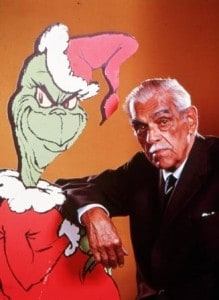 n 1966, he leaves a touching memorial to mid-’60s TV. In the seasonally re-re-showing of Dr. Seuss’ How the Grinch Stole Christmas, the actor’s gravelly narration captures both the ire and the later conversion of the slick old Grinch. In its half hour, the cartoon is far superior to the four-times-as-long Jim Carrey remake in 2000—noisy, dismal and saved in its insipid attempts to also be a musical by two songs, both from the original cartoon.
n 1966, he leaves a touching memorial to mid-’60s TV. In the seasonally re-re-showing of Dr. Seuss’ How the Grinch Stole Christmas, the actor’s gravelly narration captures both the ire and the later conversion of the slick old Grinch. In its half hour, the cartoon is far superior to the four-times-as-long Jim Carrey remake in 2000—noisy, dismal and saved in its insipid attempts to also be a musical by two songs, both from the original cartoon.
Four years after Karloff appears in The Bride of Frankenstein, 1935, Lugosi, Karloff’s partner or adversary in so much crime and horror, makes two totally different films, Ninotchka, a minor part but something of an escape from his usual, and Son of Frankenstein as Ygor, the monster’s acolyte. Well into its decline by now, Lugosi’s career does have the occasional hesitation, a partial upturn. In the last truly Lugosi vehicle, for example, he is back in form in The Human Monster, playing two roles. Although Night Monster has a novel premise—a man’s legs can briefly materialize for killing purposes—the Grand Guignoling is assumed by Ralph Morgan, and Lugosi is reduced to butler status, pulling out chairs and announcing dinner for the likes of larger-roled Lionel Atwill, Nils Asther and Leif Erickson.
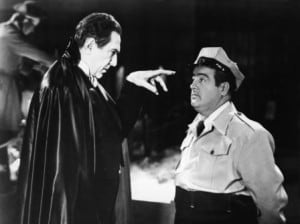 Night Monster is typical of the diminished roles to come—and the avalanche of mediocre films. With make-up hiding much of the actor’s by now gaunt face, there is a momentary reprieve in Abbott and Costello Meet Frankenstein, perhaps the best movie of that popular comic team and a kind of last hurrah for the actor. All the Universal gang are here for a last reunion—the monster, Wolf Man and, for the first time in seventeen years, Lugosi is Count Dracula again. He makes only two further appearances as the Count, and those for TV.
Night Monster is typical of the diminished roles to come—and the avalanche of mediocre films. With make-up hiding much of the actor’s by now gaunt face, there is a momentary reprieve in Abbott and Costello Meet Frankenstein, perhaps the best movie of that popular comic team and a kind of last hurrah for the actor. All the Universal gang are here for a last reunion—the monster, Wolf Man and, for the first time in seventeen years, Lugosi is Count Dracula again. He makes only two further appearances as the Count, and those for TV.
Lugosi had been introduced to morphine by doctors who suggested it would relieve his kidney ailment pain. Later, down to only half a kidney, his addiction would increase, and the side effects of methadone and Demerol, not to mention his wife’s desertion and then divorce, would wreak havoc on both his body and his life. Following self-admittance to a rehabilitation clinic, he undergoes something of a recovery. He makes one more official film, The Black Sleep (see review). It includes a respectable cast—Basil Rathbone, John Carradine, Lon Chaney, Jr. and Akim Tamiroff—but Bela, once again, is relegated to a butler, only now mute. Later that year, 1956, his fifth wife Hope finds him dead in their apartment.
Most of the supporting stars of The Invisible Ray turn in relatively solid performances. The best of all, aside from Cooper, is possibly the English-born Kingsford. He usually plays, as here, serious, non-threatening roles, best-remembered, perhaps, as Victor in A Tale of Two Cities, Colonel Sandherr in The Life of Emile Zola and, most of all, as Dr. Walter Carew in the Dr. Kildare series. Like most actors of the time, he went mainly into TV beginning in the early ’50s, including five episodes of Alfred Hitchcock Presents.
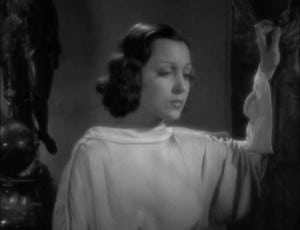 “ . . . solid performances . . . ” by all, that is, except for that by Frances Drake. Hers remains something of a curiosity. After the advent of sound when the flagrant emoting of the silent stars was no longer considered the essence of great drama, her performance in The Invisible Ray is a textbook example of those numbered and exaggerated poses—sad, happy, angry, loving. Brings to mind the 1936 My Man Godfrey: Carole Lombard, with upturned eyes and arched back, is embroidering for the family her distress over her unrequited love for butler William Powell. From the sofa, her observing sister Gail Patrick remarks, “Oh, I remember that pose so well. I learned it in dramatic school. It’s No. 8, isn’t it?”
“ . . . solid performances . . . ” by all, that is, except for that by Frances Drake. Hers remains something of a curiosity. After the advent of sound when the flagrant emoting of the silent stars was no longer considered the essence of great drama, her performance in The Invisible Ray is a textbook example of those numbered and exaggerated poses—sad, happy, angry, loving. Brings to mind the 1936 My Man Godfrey: Carole Lombard, with upturned eyes and arched back, is embroidering for the family her distress over her unrequited love for butler William Powell. From the sofa, her observing sister Gail Patrick remarks, “Oh, I remember that pose so well. I learned it in dramatic school. It’s No. 8, isn’t it?”
Early in the beginning of The Invisible Ray, setting the general tone of her demure theatrics, Drake stands alone beside a window, looking into the distance, thinking to herself—the gear changes visible on her face—“I’m to look pensive, perhaps confused, for three seconds. Hold it!” Her breath not heard though visibly obvious, she sighs heavily, turning her head, eyes cast down. “And, now, I will look thoughtful . . . one, two, three . . . for five seconds.” Or, rather, gentle reader, maybe she’s thinking, “How did I get involved in this film?”
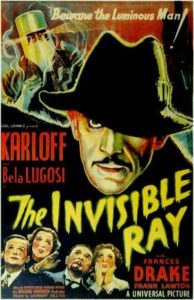
It’s a bit inaccurate to list Goerge Robinson as the cinematographer for “Dracula” without further comment. The version with which most people are familiar (the one with Bela Lugosi) was, of course, shot by German Expressionist Karl Freund, who would go on to direct Karloff in “The Mummy.” Robinson did shoot the Spanish version of the same film, done at night on the same sets with star Carlos Villarias. That version is now widely-enough available that most serious fans have seen it, but it’s best not to conflate the two of them.